M. Isidora Forrest's Blog, page 14
June 4, 2023
A Summer Solstice Isis Rite

We’re not quite there yet, but I thought you might like to have this small rite early in case you’d like to find a special outdoor place to celebrate the coming solstice.
In Egypt, about 3000 BCE, at the latitude of ancient Memphis, the summer solstice coincided with the heliacal rising of Sirius, the star of Isis, the beginning of the all-important inundation, and the coming of the new year. It was a time of joy as people anticipated the coming harvest and other blessings from the Divine Ones.
In this rite, we celebrate with gratitude the fullness of summer in the dawning light of our closest star, the sun. Yet we also know that the ba of Isis—in Her holy star Sirius—is also present with us, though still unseen by most of us in the northern hemisphere.
 The summer solstice sunset at Karnak temple
The summer solstice sunset at Karnak templeAnd, of course, Isis is a Sun Goddess, too.
Stuff You’ll Need
For this rite, you’ll need Nile water and a vessel, a flowery incense and something to safely burn it in, your sistrum, and a ripe avocado or sweet, juicy fruit like a peach, and something to cut it with. You’ll be eating the fruit in offering communion with Her, so make it something you like.
Your Temple Space
Ideally, this is an outdoor space where you can see the sun rise on summer solstice. Make sure you arrive before sunrise. If not possible, you can also do this indoors, visualizing the sunrise.

Arising
Rattle your sistrum softly at your heart. As you see the sun rise, stand and open your arms like the wings of Isis.
Ritualist: (Vibrating softly) ISET-RE, ISET-SOPDET! (Speaking softly) I welcome You with open heart into Your abode (moving your hands to cross upon your heart).
Purifying the Heart
Pour the Nile water into the vessel. Sprinkle water upon your own body, paying special attention to your heart.

Ritualist: Purify, purify, purify, purify! I am purified by the Mother of Rivers, the Lady of the Living Waters. Into Her care I release al pain, all anger, all frustration, all regret—all the sorrows of my heart. (Breathe deeply and repeat until you feel that it is so.)
The temple of my heart is made new, purified and opened unto Isis, the Lady of Abundance.
Awakening the Heart
Take up the sistrum again, light the incense. Rattling the sistrum softly at your heart (so much the better if you can feel the vibrations of the sistrum), say,
Ritualist: In the name of Isis-Re, in the name of Isis-Sothis, my heart awakens. (Breathe deeply and repeat until you feel that it is so.)

Be seated comfortably. Now listen and hear. Listen to the dawn and find the heartbeat of the Great Goddess Isis. Her noble heart beats all around you. In the awakening song of birds. In the wind moving through grass and trees. In the waters. In the deep earth.
Find the heartbeat of Isis.
Now, touch a pulse point on your own body and find your heartbeat.
Attune your heartbeat to Hers, slowing or speeding up as needed. (Just do the best you can; it doesn’t have to be perfect.)
Ritualist: (Speaking softly to yourself and to the Goddess) Iset Ib, my heart’s desire. Her heart. My heart.
I am aware in my heart. I am in power in my heart. I am aware and in power in my heart, which is the heart given to me by my mother (stating the name of your human mother)—and by my Great Mother Isis.
Iset Ib, my heart’s desire. Her heart. My heart.
I am intelligent in my heart. I am compassionate in my heart. I am intelligent and compassionate in my heart, which is the heart which drums in rhythm with the heart of Great Isis.
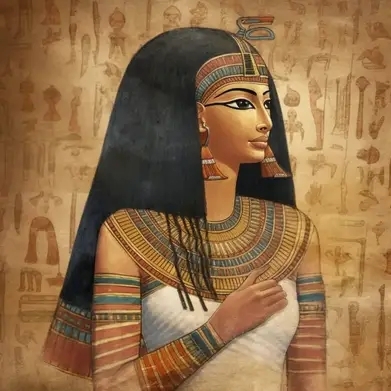
Iset Ib, my heart’s desire. Her heart. My heart.
I am alive in my heart. I am full in my heart. I am alive and full in my heart, the center of all Being, the beginning of all Becoming. I am alive and full in my heart, and my heart knows all the joys and pleasures of my life.
In the fullness of my Being, I am Becoming joyful. Isis arises—all is well. Isis comes—peace returns. I am sitting in the Throne of Abundance. Once again, I attune my human heart to Her Divine heart (pausing to do this).
Now speak aloud at least ten things for which you are grateful. If you can name more than that, do so. Let yourself feel joy, satisfaction, pleasure, or pleasant surprise as you name each thing. Take time to re-attune your heart to the Goddess’ heart between each thanksgiving. When you are finished, continue:
Ritualist: Iset Ib, my heart’s desire. Her heart. My heart. I am aware in my heart and I am grateful in my heart. You have blessed me, Isis, and I bless You. Amma, Iset. Grant that it ever be so.
Communion of the Heart of Isis

Take out the avocado (or other fruit) and look upon it.
Ritualist: This fruit is the fruit of the holy persea tree, sacred unto Isis. It is the fruit of the tree from between whose branches rises the Soul of Isis—Sothis—and the Face of Isis—the Sun. The wise say that the sacred persea bears the Heart of Isis (elevating fruit), therefore when I hold this persea fruit in my hands, I hold the Heart of the Goddess. Rich and sweet, the persea fruit is indeed the Heart of the Beautiful One, the Heart of Abundant Summer.
Cut the fruit into five pieces and lay them upon the altar like the five-rayed Star of Isis.
Ritualist: O Isis-Re, O Isis-Sothis, You shared with me Your sacred heart (eating one piece of fruit). Spirit is joined to spirit (eating another piece of fruit). Mind is joined to mind (eating another piece of fruit). Soul is joined to soul (eating another piece of fruit). Body is joined to body (eating the last piece of fruit). Heart joined to heart (crossing your hands over your heart).
Closing

Take up the sistrum and, beginning at your heart, rattle it in the four directions, above you and below you.
Ritualist: O Isis, You have filled my heart. You are indeed the Lady of Abundance.
Take up the vessel of water. Holding it at your heart, sprinkle water in the four directions, above you and below you.
Ritualist: O Isis, I ask that my heart remain open to Your heart, this day and every day. Amma, Iset. Grant that it be so.
Face east and the rising sun and the hidden star. Open your arms like the wings of Isis, then close them over your heart. Remove all traces of your presence, then depart in peace.

NOTE: This is a shortened version of the summer solstice rite from Isis Magic. For the more complete rite, see pages 344-351 in the second edition.
May 28, 2023
Isis the Rebel
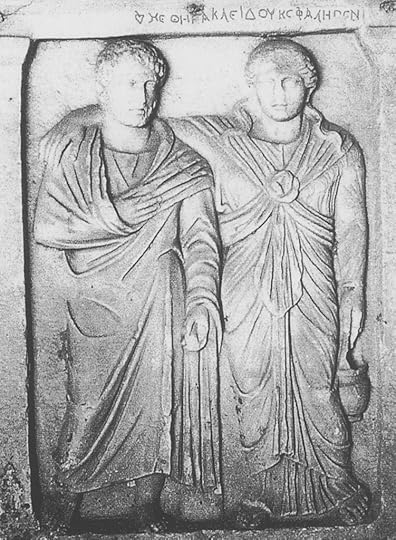 Athenian grave stele with the woman in Isiac dress; note her embrace of her (I presume) husband, which is reminiscent of many Egyptian couples’ funerary images.
Athenian grave stele with the woman in Isiac dress; note her embrace of her (I presume) husband, which is reminiscent of many Egyptian couples’ funerary images.You might remember from last week all those Athenians who had themselves represented on their grave steles in specifically Isiac garments. In fact, one-fifth of all the grave steles from the period when Athens was ruled by Rome are women in Isiac dress. There are also steles for several Isiac men, but it’s mostly women.
In Athens.
For a non-Greek Goddess.
I’m reading a scholarly article now that suggests that this way of having themselves represented in death was an Athenian response (perhaps unconscious) to Roman imperialism. The idea is that these people chose to represent themselves as “other” than the standard Greco-Roman way because it let them preserve some of their individuality and personal power (as well as cultic status) in an era when they felt they had little of it politically. (And, of course, these were mostly women, people who have had little political power at the best of times, in ancient society and now in many places.)
In other words, these people were rebelling against Roman societal rule in a way that helped them fashion new and more complex selves—and Isis helped them do it.
 The 1990 debut album of Lin Que, rapping under the name of Isis, was Rebel Soul.
The 1990 debut album of Lin Que, rapping under the name of Isis, was Rebel Soul.Although you still see Isis described as “the ideal wife and mother”—which often has the connotations of 1950s housewife—I’ve always thought of Her as rather rebellious in that She does what She wants to do, not letting anything stop Her.
That’s why I was taken aback when a friend once remarked to me that she couldn’t get into Isis because of the subservient way She went around “picking up after Osiris.” My friend was, of course, referring to the main Isis-Osiris myth in which Isis travels the length and breadth of Egypt to find and conduct proper funeral rites over the scattered pieces of Her murdered husband’s body.
 I love this
I love thisFor its day, I have always considered the ancient myth of Isis to be pretty darned feminist, modeling both feminine power and independence. My own feminism is one of the reasons I began exploring Goddess in the first place.
So my friend had seen the Isis-Osiris myth as just another “woman-taking-care-of-her-man” story, while I’d seen it as the opposite: a tale of the reversal of stereotypes. Instead of the prince saving the princess, the princess had to save the prince, put him back together, and give him renewed life.
We were both right, of course. A myth speaks to us however it speaks to us. Yet, I do think that Isis and Her cycle of myths, especially when you include the important Isis & Re story, provide a proto-feminist model.
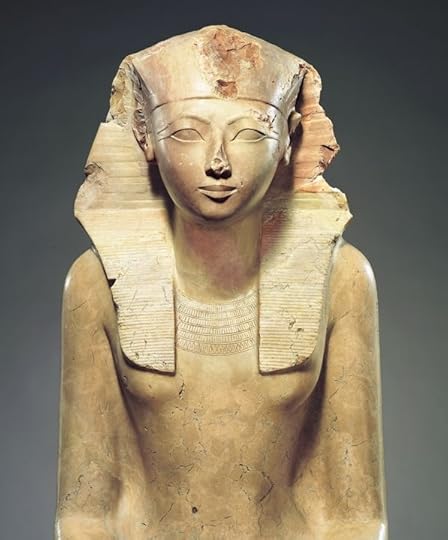 The woman pharaoh Hatshepsut
The woman pharaoh HatshepsutPart of the credit for this goes to ancient Egyptian society. While we should have no illusions that men and women were true equals in Egypt, still they were more equal in Egypt than in any of Egypt’s Mediterranean neighbors. In Egypt, women could hold and sell property; they were considered (at least theoretically) equal to men before the law; they could instigate lawsuits; they could lend money; and although it was unusual, a woman could live independently, without a male guardian. In contrast, Greek and Roman laws firmly relegated women to control by their husbands or male relatives and provided little economic or legal protection to women.
So when Isis’ myths depict Her acting autonomously for Her own ends or wielding power, this type of female behavior was not as strange in Egypt as it was in the rest of the Mediterranean world. Another example of Isis wielding power are the tales of Isis as warrior that we have from the tales in the Jumilac papyrus.
Even when Egypt was ruled by non-natives under the Ptolemies (from 305 to 30 BCE), the native Egyptian respect for the feminine and The Feminine seems to have crept in. By the end of the dynasty, the historian Diodorus Siculus (Diodorus of Sicily) could write that due to the success of Isis’ benevolent rule of Egypt (while Osiris was on His mission to civilize the world):
…it was ordained that the queen should have greater power and honor than the king and that among private persons the wife should enjoy authority over her husband, the husbands agreeing in the marriage contract that they will be obedient in all things to their wives.
Diodorus Siculus, Book II, section 22
This wasn’t true, but it is interesting that that would be the impression that Diodorus received when visiting Egypt and speaking to Egyptians.
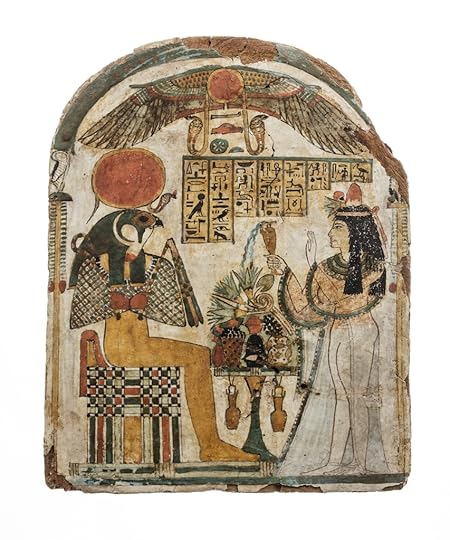 The deceased lady, Djed-Khonsu-iw-es-Ankh, worships Re-Horakhty in the Otherworld
The deceased lady, Djed-Khonsu-iw-es-Ankh, worships Re-Horakhty in the OtherworldI’m also reading an article in the Journal of Hellenic Studies by Rachel Evelyn White about women in Ptolemaic Egypt that discusses the possibility that the family tomb may have been the property of a female heir, and which was likely a holdover from ancient Egyptian tradition. This is based on some Egyptian contracts of the time combined with the fact that this was specifically the case among the nearby Nabataeans. If so, this could be one of the bases for retained female power in Egypt, as well as giving women another connection with Isis as the provider of proper burial and funerary rites. It may also point to very ancient matrilineal traditions in Egypt.
We should also recall that in several of the remaining Isis aretalogies, the Goddess declares women’s equality with men. What’s more, the relationship between women and men is meant to be friendly and loving—like the relationship modeled by Isis and Osiris. The aretalogy from Maronea states that Isis established language so that men and women, as well as all humankind, should live in mutual friendship.
In a later Hermetic text entitled Kore Kosmu, Isis explains to Horus the origin and equality of male and female souls, declaring that:
The souls, my son Horus, are all of one nature, inasmuch as they all come from one place, that place where the Maker fashioned them; and they are neither male nor female; for the difference of sex arises in bodies, and not in incorporeal beings.
Scott, Walter, Hermetica, Vol. 1 (Boulder, Colorado, Hermes House, 1982), p. 499-501.
The states it quite plainly: “Thou [Isis] didst make the power of women equal to that of men.” I know of no other ancient texts that lay out the message of equality so strongly as is done in the Isis aretalogies and hymns.
And so, I honor Our Lady, Isis the rebel and Isis the feminist.
May 21, 2023
Isis Outside of Egypt
 A statue of Isis from a private sanctuary of the Egyptian Gods near Marathon, Greece built by a Roman statesman.
A statue of Isis from a private sanctuary of the Egyptian Gods near Marathon, Greece built by a Roman statesman.How many of us were Egyptophiles from very early on in our lives, even as children? That’s true of me. You, too?
The power of ancient Egypt is magnetic, irresistible. And our Goddess Isis is perhaps THE most well known—and for some of us, most magnetic and irresistible—of the representatives of Her ancient homeland.
We are not alone in our attraction to Egypt and to Isis. We’re not alone today, and we’re not alone historically. Fascination with Egypt and devotion to Isis spread far beyond the borders of ancient Egypt. In the beginning, Isis was a local Deity. Eventually, Her worship and that of Osiris spread throughout much of Egypt. By the 5th century BCE, the Greek historian Herodotus said Theirs was the only pan-Egyptian worship. (This isn’t so, but it shows how widely their worship had spread within Egypt.)
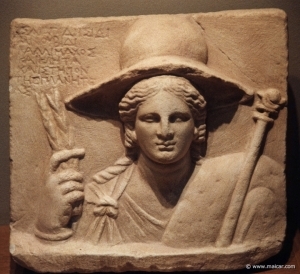 Isis from a temple in Macedonia, 2nd century BCE
Isis from a temple in Macedonia, 2nd century BCEEven during archaic times (as early as 800 BCE), we see traces of devotion, such as inscriptions or votive images, outside of Egypt. By the 4th century BCE, Isis and Her family were adopted into Nubia to the south of Egypt and Greece to the north. Then, from the beginning of Ptolemaic rule in Egypt (305-30 BCE) through the Roman Empire, devotion to Isis spread very quickly.
Due to some ancient documents we still have, we can know that the first temple of Isis was built in Greece, in the Piraeus, Athens’ port city, by the late 4th century BCE. I found an article detailing how that may have come about.
The first thing we hear of it is in a legal document that the folks who had received said document had carved in stone and set up in the Piraeus. They wanted to make sure there would be no mistake that they had proper permission. The people who had it carved were from Cyprus and they had gained permission to set up an Aphrodite sanctuary. The interesting thing for Isiacs is that they had done it on the precedent of Egyptians having built a sanctuary of Isis in the same area. The document is dated to 333/2 BCE. So this means that the formal worship of Isis was established in the Athens area sometime before 333/2 BCE. On the Greek holy island of Delos, sometime about this same period, an altar dedicated to Isis is the oldest of the inscriptions related to the Egyptian Deities.
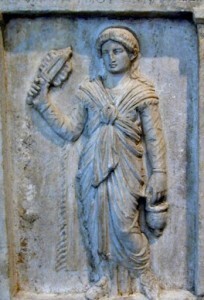 Funerary relief of Sosiba in the dress of Isis, from Attica
Funerary relief of Sosiba in the dress of Isis, from AtticaThe person who had proposed that Athens grant this permission to the Cyrians was a guy named Lycurgus who was in charge of Athenian finances, and so was quite powerful. At least one scholar has suggested that he had something of a personal interest in the previous Isian sanctuary. His grandfather, also named Lycurgus, may have been the one who proposed that the Egyptians be allowed to build their sanctuary. If it was Lycurgus senior who was connected with the Egyptians and their sanctuary, then that would put the establishment of an Isis temple at Athens about the late 5th century BCE.
However, getting foreign sanctuaries built was not an easy thing. And in fact, Lycurgus senior was thoroughly mocked for his promotion of the Egyptian Deities. He was nicknamed “Ibis” in Aristophanes’ comedy, The Birds. An ancient scribe commenting on this nickname opined that he was called that either because he was Egyptian by birth or due to “his Egyptian ways.” A fragment from another comedian pictured Lycurgus wearing a kalasiris, the long, form-fitting sheath dress of an Egyptian woman. Yet another suggests that Lycurgus might be carrying messages home to “his fellow countrymen” in Egypt.
 A reproduction of a sacred image of Isis from the private sanctuary near Marathon that is on site today
A reproduction of a sacred image of Isis from the private sanctuary near Marathon that is on site todayMost scholars are pretty sure Lycurgus senior wasn’t Egyptian—and are certain that he was an Athenian citizen—but it seems that he may have indeed been an Egyptophile. What we don’t know for certain is whether Lycurgus the younger was actually the grandson of Lycurgus the Ibis. So there may be no connection at all and the names merely coincidental. The author of the article I’m reading suggests that grants to both to the Isis and Aphrodite devotees may have been more political than religious. Athens had suffered some defeats during this time period. The author suggests that Lycurgus the younger was welcoming sanctuaries from other areas so that he could help build up Athens’ trade and thus its economic power. So it’s always money.
While it may have been money for Lycurgus the financial administrator, it wasn’t just money for other Isis-interested people in the Mediterranean. For instance, we see more Greek parents parents giving their children names that included Hers at about these same times. Scholars generally agree that when we see an upswing in what are known as theophoric names (“Deity-Bearing” names; for instance, “Isidora” is a theophoric name), we are witnessing an increase in the Deity’s popularity as well. In Greece, we see a few Isis-bearing names in the 3rd century BCE, many in the 2nd century BCE, then an absolute explosion of Isis names from the 1st century BCE through the Roman Imperial period.
Perhaps even more interesting is that people may have taken names that included Hers as a sign of their devotion. This is not so different today. My own theophoric name is a taken name that I legally changed to permanently connect me with Her. And I know I’m not the only one.
 Grave stele of Mousa, daughter of Dionysios, dressed as an Isiac
Grave stele of Mousa, daughter of Dionysios, dressed as an IsiacIsis may have been especially important in Miletus, an ancient Greek city in what is now Turkey. There are five women, known from their funerary reliefs, who all bore the name Isias (or Eisias) and had come to Athens from Miletus. Some scholars have suggested that these women may have been former slaves who were freed in the name of Isis and therefore took the name of their deliverer. Others have suggested that they were initiates of Isis who took Her name—or that they may have been both.
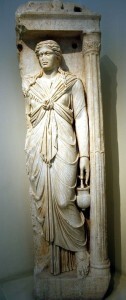 Funerary relief of Alexandra in Isis dress, from Roman-era Athens
Funerary relief of Alexandra in Isis dress, from Roman-era AthensThe five Isis-named women were shown on their grave reliefs in the famous “dress of Isis,” that is, the fringed mantle with Isis knot, and holding the sistrum and situla. But theirs were not the only examples. In fact, we know of 108 such Attic reliefs of women and some men with Isis attributes; the women wear the Isis-knotted dress, while the men hold the sistrum and situla. During the Roman period in Athens, this number makes up one-third of all the known (and published) grave reliefs. If that number reflects true percentages rather than just chance, that’s an awful lot of Isiacs.
In addition to the possibility that these Isis-accoutered people were initiates of Isis, it has also been suggested that they may have either been priest/esses, had a priest/essly function, or may simply have been especially enthusiastic devotees; for example, volunteers who helped maintain the sanctuaries and participated in the rites.
Or they may have been members of religious associations that were connected with the sanctuaries and served both a religious and social function. We know of one such group in particular that was connected to one of the Isis-Sarapis sanctuaries on Delos. It seems likely that enthusiasts would be members, or even founders, of such associations.
People could also stay for a time at the temples. In Apuleius’ tale of initiation into Isis’ Mysteries, prior to deciding to be initiated, his character Lucius simply spends time in Isis’ sanctuary:
I took a room in the temple precincts, and set up house there, and though serving the Goddess as layman only, as yet, I was a constant companion of the priests and a loyal devotee of the Great Deity.
Apuleius, the Golden Ass, Book XI, 19
I wish he had described what specific things he, as a layperson, was allowed to do to serve the Goddess. He does describe, in part, the morning rites to which the public seems to have been welcomed:
I waited for the doors of the shrine to open. The bright white sanctuary curtains were drawn, and we prayed to the august face of the Goddess, as a priest made his ritual rounds of the temple altars, praying and sprinkling water in libation from a chalice filled from a spring within the walls. When the service was finally complete, at the first hour of the day, just as the worshipers with loud cries were greeting the dawn light…
Apuleius, the Golden Ass, Book XI, 20
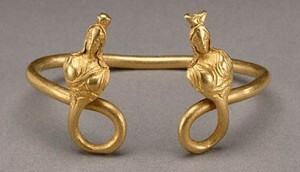 A Hellenistic bracelet with two busts of Isis, made in Egypt
A Hellenistic bracelet with two busts of Isis, made in EgyptFrom the evidence we have from Greek Isis sanctuaries, it seems that the Greeks used priest/essly titles they were familiar with, but with adaptations to fit Isis’ mythos. We have records of a hiereus, a priest, a stolistes, one who adorns the sacred image of Isis, a zakoros, an attendant, a kleidouchos, a key bearer, and a melanophoros, a bearer (or wearer) of the black garments—Isis’ black garments of mourning. We can expect that Isis received offerings of food and drink, as did native Greek Deities.
We have mentions from several Roman writers about devotions to Isis. The poets Propertius and Tibullus complain of the period of sexual abstinence their mistresses undertook for Isis. Ovid writes of the crowds of penitents at the temple of Isis. Tibullus also mentions a ritual called votivas reddere voces in which devotees could join in the singing of the virtues (aretai) of Isis in front of Her temple twice a day. (I wonder if they used any of the aretalogies of Isis we know of.)
 A Renaissance statue of Isis by the sculptor Andrea Bregno, in the style of ancient Rome
A Renaissance statue of Isis by the sculptor Andrea Bregno, in the style of ancient RomeInterestingly, when Isis comes to Rome, Her Roman worshipers seemed to have tried to make Her worship more “Egyptian” than did Her Greek worshipers. For instance, Roman Isis temples celebrated the rising of Sothis. They added back Egyptian symbols, such as the divine animals: crocodile, baboon, and canine. We see the development of lifelong priesthoods, something done in Egypt, but not done in Greece. Some Roman emperors may have especially appreciated the Egyptian relationship between Isis the Throne and the pharaoh. And it is in Italy that we first see priestesses of Isis rather than just priests.
For modern devotees, knowing the ways in which our spiritual ancestors—whether in Her homeland of Egypt or outside of its borders— honored Isis can inspire us in developing our own ways to honor Her. Whether we make offerings of food upon Her altar, pour libations of milk and wine, or sing of Her virtues before our shrines, we honor the Goddess Who fills our hearts and we connect with those who have gone before us.
May 14, 2023
The Mother of Isis
 A most beautiful Nuet
A most beautiful NuetWhile Isis is Herself a Mother Goddess, She also has a Divine Mother. Isis’ mother is Nuet (Nut, Nuit), the Great Egyptian Sky Goddess.
I am not Nuet’s priestess, but O, the Secret One draws me. I am awed by Her Eternity, Her Depth, Her Beauty, and I want to lose myself in Her. And right now, on this Mother’s Day in the US, in the northern hemisphere, Our Lady Isis is Herself lost within the beautiful body of Her mother Nuet.
Right now, the star of Isis, Sirius, is hidden. Here in Portland, Oregon, She will not be seen again until pre-dawn in late August. Astronomically, that’s because the star is in conjunction with the sun. As the sun rises, its greater light makes the light of Sirius invisible to us. By late August, Sirius and the sun will move further away from each other so that, just before dawn, we can once more see the brilliance of the star in the twilight sky.
But that’s just astronomically. Mythically, Isis sojourns within the body of Her powerful mother Nuet. She Who is called the Mistress of All and the One Who bears the Gods and Goddesses. She is the Splendid and Mighty One in the House of Her Creation. She is the Great One in Heaven and the “indestructible stars” (that is, the circumpolar stars that are always visible) are said to be in Her.
Nuet embraces the deceased king and each of us “in Her name of Sarcophagus” and “in Her name of Tomb.” She is the Mistress of the Secret Duat (the Otherworld). She is the Glowing One (perhaps as the Milky Way) and in Her we are joined to our stars, Becoming Divine. She is the one Who gives birth to us and Who welcomes us back into Her starry body at our deaths. She is Heaven and She is the Otherworld. She gives birth to the Sun God Re each day and receives him back into Her body, by swallowing, each night. She is the one Who is “Amid the Iset Temple in Dendera” for She is over Her daughter and Her daughter is in Her.
 Nuet, the Circle of Eternity, encompassing All
Nuet, the Circle of Eternity, encompassing AllBut now, while Isis is in Her mother’s womb, She is also in the Underworld for Nuet is the Lady of the Duat and Her body is both the Heavens and the Underworld. So now in the rising heat of the year, our Goddess is in the cool depths of Eternity. Perhaps this is the time for us, as Her devotees, to enter the Otherworld as well.
 Sopdet (Sirius), the Star of Isis
Sopdet (Sirius), the Star of IsisWe usually think of symbolically going into the Underworld during the endarkening time of the year rather than the enlightening. Yet now, with the rising of the light until summer solstice, it may be a particularly safe time to take that Underworld journey, for now we have the support of Isis Who awaits us there.
If we have scary things to face in our own personal Underworlds, now is a more supportive time to do so. The light of dawn comes more quickly now and the sunlight of Isis the Radiant One is more readily available to us after we have faced those inner darknesses that we must face in order to grow.
This may also be a good time to explore our relationships with our mothers. A strong priestess of my acquaintance, who was serving as a Priestess of Nuet at a festival a while ago, told me an interesting thing about how she perceived the relationship between Nuet and Isis. It was her distinct impression that Nuet did not get along with Her daughter. Of course, in the human realm, this is far from an uncommon thing. Mothers and daughters (and mothers and all their children, for that matter) can have issues. Now, with the light of the coming summer and the help of the Goddesses available to us, might be a time to shed some light on those issues.
 Sarcophagus lid with Nuet opening Her protective wings over the deceased
Sarcophagus lid with Nuet opening Her protective wings over the deceasedBut even if we don’t have mom stresses, this can be a time to honor our mothers, both human and Divine—perhaps under a star-filled sky. Since my own mother has already been enfolded in the wings of Isis, I shall plan to honor my Divine Mother Nuet and Her Starry Daughter, Isis tonight, for we are forecast a clear and starry night.
May 7, 2023
Magical Images & Isis
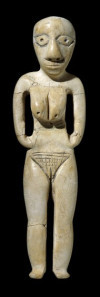 A female image in hippopotamus ivory from the early predynastic period from Badari
A female image in hippopotamus ivory from the early predynastic period from BadariAs with so many things in Egyptology, there’s controversy surrounding the many female figurines that have been found throughout Egypt and spanning its long history.
These figurines take several forms. Some are standing females, usually nude with sexual characteristics emphasized (eyes, breasts, vulva). Some are abstracted into what have been called “paddle dolls”; more on them shortly. Some show a woman lying on a bed, often with a baby or child beside her. Others show a woman nursing a child.
The old gentlemen of early Egyptology initially guessed that the nude females and paddle dolls—some of them found in tombs—were “spirit concubines” for deceased Egyptian men. Because of course they did. However, the fact that they have been found in the tombs of women and children, too, throws a significant monkey wrench into that interpretation.
There’s also the more modern controversy about whether ancient female figurines should be interpreted as images of Goddesses or even as representations of an all-encompassing Mother Goddess. In opposition are those who regard the figures as devoid of divinity altogether and more likely to have been toys, ancestor figures, tools for sex instruction, or as mentioned above, the ever-popular post mortum concubines.
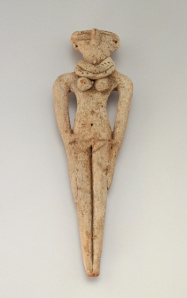 A Second Intermediate Period image
A Second Intermediate Period imageWhile the idea of a singular worldwide Goddess cult goes farther than strict interpretation of the evidence can take us (and, in fact, that is not what most proponents of the Goddess interpretation claim), the virulence of the opposition makes me question its objectivity as well. The truth is, we just don’t know. We have no ancient texts explaining these figures for us. Yet, at the very least, the ubiquity of the female figurines as well as their greater numbers in comparison to extant male figurines indicates a keen interest in the feminine by our ancient siblings.
Female figurines in Egypt
These images are also commonly interpreted as general “fertility symbols.” This makes sense due to the emphasized sexual characteristics of many figurines and the connection with the child in others, as well as the fact that a number of them seem to have been given as votive offerings to the Great Goddess Hathor, one of Whose concerns is fertility. Hathor also received what one Egyptologist described as “basketsful” of clay phalluses.
Another cache of these images that has received study come from the temple precinct of the Great Mother Mut. Of the small handful of votive images that include inscriptions, all are requests for children. In addition to temples and tombs, these figures have also been found in ancient homes and in domestic shrine settings.
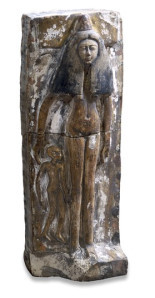 19th dynasty image of a woman and child on a bed
19th dynasty image of a woman and child on a bedMany modern Egyptologists have come to the consensus that the female figurines are symbols of fertility in its the broadest sense, which includes the ideas of general health and well-being, rebirth and regeneration—in addition to concerns with human reproduction.
There are some other interesting ideas as well. One that I hadn’t come across before is the idea that the paddle dolls are related to a specific type of royal and sacred musicians and dancers.
Paddle dolls
Paddle dolls are flat images with truncated arms, no legs, an emphasized vulva, decorative painting on the body, big hair—and sometimes no head, just a large mop of beaded hair. (See more on the magical importance of Isis’ hair here.) They were first called paddle dolls because of the flat, paddle-like body shape and dolls because they were thought to be toys; some even looked to the archeologists like they had been played with by a child. The largest number of paddle dolls have been excavated from the cemeteries around Thebes in Egypt.
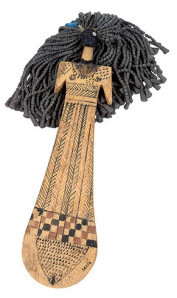 One of the big-haired paddle dolls with emphasized vulva
One of the big-haired paddle dolls with emphasized vulvaIn a paper on the subject, Ellen F. Morris follows a variety of interesting lines of evidence to conclude that the paddle dolls were meant to be representations of the khener-women. Members of the khener were once thought to be part of the pharaoh’s harim, but now are understood to have been skilled and respected musicians and dancers.
Married women and men could also be part of a khener. The khener could be connected to the royal household, to temples of the Deities, and to mortuary temples. When associated with the temples, it seems reasonable to think of them as priest/esses of music and dance.
The story of the birth of the three kings told in the Westcar Papyrus indicates that the women of the khener might also serve as midwives. In this tale, Isis, Nephthys, Heqet, Meshkhenet, and Khumn are specifically said to be disguised as a khener when They deliver the three children of Reddjedet. By the time of the New Kingdom, we know that a khener was part of the worship of Isis.
On several of the paddle dolls and on a number of examples of the female figurines, cross-shaped marks were found on the upper body. Some researchers have correlated these cross marks to similar cross marks seen on the bodies of partially nude female mourners in some New Kingdom tomb paintings. In some of these, two of the mourners are specifically identified as Isis and Nephthys. Scholars have theorized that the partial nudity may refer to Isis’ use of Her arousing sexuality to help bring Osiris back to life. This strengthens the argument that at least some of the female figurines were tools of resurrection, imbued with the arousing power of Isis. This ability of the nude or partially nude figures to induce (male, heterosexual) arousal may hold a key to the reason why they may be considered fertility figures. For potency—in life or after life—the male must be aroused and the female must arouse him.
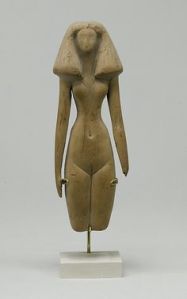 A particularly beautiful 12th dynasty image from Thebes
A particularly beautiful 12th dynasty image from ThebesMagical images
There are other possible uses for these figurines as well. Some researchers have suggested that they were purposely generic so that they could be assigned magical roles as need be. Healing seems to have been a common use. We have a ritual text that instructs the sufferer to recite a particular spell “over a woman’s statue of clay.” The spell, in the Leiden Papyrus (3rd century CE), is to cure a bellyache. Once the spell is spoken, the papyrus says that “the affliction will be sent down from him into the Isis-statue until he is healed.” (Would you like that in Egyptian? It is repyt Iset, “a female image of Isis.”)
We also find images of Isis used in relation to healing from snakebite. A spell in the Turin Papyrus (First Intermediate Period) instructs the ritualist to use “this clay of Isis that has come forth from under the armpit of Selket” to ward off a snake. In this case the spellworker is to enclose a knife and a particular herb within the clay. We can’t be completely sure whether the “clay of Isis” was in the form of Isis or used to form an image of the Goddess. Some scholars think that it likely was in the form of the Goddess and that the spell in full should read “this clay figure of Isis.”
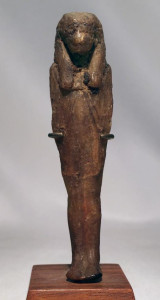 A Ptolemaic beeswax image of one of the sons or Horus
A Ptolemaic beeswax image of one of the sons or HorusIn addition to clay, magic workers also used beeswax to form their magical images. Figurines made of beeswax are known from the magical papyri and, in specific relation to Isis, from Diodorus Siculus (1.21, 5-6). He says that the Goddess used wax to create multiple figures of Osiris, which She then gave into the keeping of priests throughout Egypt so that Osiris could be buried in locations throughout the land and thus to be widely honored.
A number of the female figurines we’ve found are broken. Originally this was thought to have been accidental. Now scholars are more inclined to think the state is purposeful. Why? Well, if they were being used in healing spells like the one in which the bellyache “went down into” the Isis statue, then to keep the bellyache from returning, it would be reasonable to break the image, permanently obliterating the bellyache with it. Modern magic workers often do the same sort of thing. Once the magic is accomplished, the talisman is dismantled, de-charged, or destroyed.
One of the books I’ve been reading on this conjectures that, given Her role in healing and protection, many of the generic female images may have been used specifically as Isis figures. The image “became” Isis with the recitation of the spell. The crude fashioning of many of the images is to be explained by the fact that, in many cases, they were intended to be disposable. Once broken and disposed, the images were no longer Isis, but simply a container for the affliction.
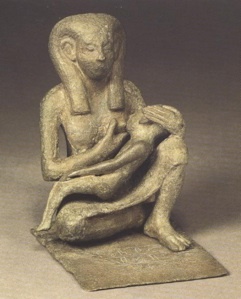 A copper image from the Middle Kingdom now in Berlin; an inscription identifies it as Isis nursing Horus
A copper image from the Middle Kingdom now in Berlin; an inscription identifies it as Isis nursing HorusImages of the nursing woman
The female figure of a woman nursing an infant is easily seen as Isis nursing Horus. Stephanie Budin argues, however, that we should not understand this specifically as Isis and Horus until the late New Kingdom. Before that time, the image reflected a variety of Divine Wet Nurses nourishing the king.
She also discusses the fascinating idea that images such as the nursing woman—as well as the other female figurines we have been discussing—might have been used to intensify magic and prayers. She refers to them as “potency figures.” (This idea is also discussed by Elizabeth Waraksa, who has studied these images from the Mut temple.) In other words, the images were a kind of magical battery that empowered the ritual.
I like this idea very much. It’s also excellent magical practice. Modern priest/ess magicians would call it adding “correspondences” to the rite. Colors, stones, herbs, and symbols that relate to the ritual purpose can be used to help the magic worker “tune in” to the divine powers that can assist in accomplishing the magic of the rite. In the case of the nursing woman images, our ancient Egyptian might be tuning in to the nurturing or protective powers of Isis.
Budin also suggests that, alternatively, the nursing-woman images (for example, the one now in Berlin pictured above) may have been used as prayer intensifiers when honoring Isis and Horus. In this case, the image would serve as an offering as well as a magical battery.
All of these are interesting ideas and each makes sense in certain contexts. To me, it seems likely that the answer is “all of the above.” Egypt was an image-intensive society. The images were probably used in a wide variety of ways, some of which we may have deduced, some of which, as yet, we have not.
April 30, 2023
Isis & Hathor, Twins?
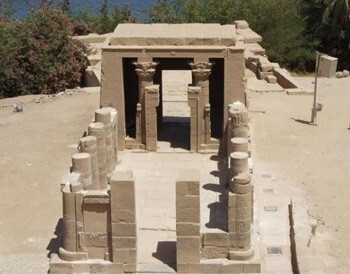 The partially restored Temple of Hathor on neo-Philae (Agilkia) island
The partially restored Temple of Hathor on neo-Philae (Agilkia) islandOn the island of Philae, east of the Temple of Isis, stands a smaller temple to Hathor. The Hathor temple was restored, at least in part, in 2012 and reopened to the public. (Both the Isis and Hathor temples, as well as the other temples of ancient Philae are now on the Egyptian island of Agilkia, aka Agilika, where they were moved prior to the building of the Aswan Dam, which created Lake Nasser and flooded Philae.)
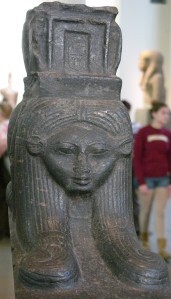 A lovely Hathor head, from a processional boat, now in the British Museum
A lovely Hathor head, from a processional boat, now in the British MuseumCompared to the Temple of Isis on Agilkia, the Temple of Hathor is quite small. Reciprocally and interestingly, at Denderah, Hathor’s great Ptolemaic temple complex, there is a similar small Temple of Isis. Clearly, there is a relationship between these two Great Goddesses; so much so that it was required that each Goddess would have a smaller temple near the great temple of the other.
In fact, sometimes that relationship between Isis and Hathor is so close that it’s hard to tell Them apart. Beginning in the New Kingdom, we regularly see Isis wearing the Horns & Disk crown of a Cow Goddess that is emblematic of Hathor. Sometimes Isis also has a small throne on top of the Horns & Disk to indicate that She is indeed Isis rather than Hathor, sometimes She doesn’t. But guess what? Hathor sometimes borrows Isis’ headdress, too.
Again at Denderah, we find a carving of Hathor—and the hieroglyphs confirm that She IS Hathor—wearing the Horns & Disk with the throne on top. It’s a bit hard to make out in this photo, but you can see the throne sitting atop the disk in Hathor’s crown.

Both Isis and Hathor are associated with Horus, Isis as His mother, Hathor sometimes as mother, sometimes as lover. Both are Cow Goddesses and Goddesses of the Sycamore, though Hathor probably has the prior claim on both these symbols. Both are Eyes of the Divine and holy Uraeus Serpents, powerful, fiery, protective and vengeful Goddesses. Thus both can become Sekhmet, that most fierce and bloodthirsty of Goddesses. Both Isis and Hathor are Goddesses of the Otherworld, Goddesses of rebirth and resurrection, Whom the dead ones adore.
Looking just as these correspondences, Isis and Hathor seem interchangeable. Is it so?
I don’t think so. Instead, They are sister branches of the Divine Tree. They are ultimately united in the Tree’s trunk, yet there is a quite palpable difference in the energy feeling of the two Goddesses—at least out in the twigs and leaves of the Tree where we most often experience Them. As you know, I have an enduring dedication to Isis, but in another part of my spiritual life, I also have a strong connection to Hathor.
 A beautiful Hathor from Hatshepsut’s mortuary temple, by Steve F-E-Cameron (own work, public domain)
A beautiful Hathor from Hatshepsut’s mortuary temple, by Steve F-E-Cameron (own work, public domain)Hathor’s energy always has an underlying feeling of excitation, of arousal. It may be sexual, but it doesn’t have to be. Hathor imparts the excitement of living, and thus She is the Great Lady of Love, Joy, Drunkenness, and Dance. Her symbol par excellance is the sistrum, the sacred rattle that is shaken to stir things up. In Egyptian, to “play the sistrum” is iri sekhem, to “do power.” Hathor has something of the maenad in Her, if I may draw from a different cultural metaphor; She’s a bit more wild than Isis, more likely to roar or hiss or spit. O, but She will dance you to ecstasy; She will love you to ecstasy; She will sing you to ecstasy. Perhaps She will also put a bit of Divine terror into your belly while She’s doing it. But then She will turn Those Eyes upon you, those soft, bright, deep cow’s eyes, and She will soothe you, take you in, and make you understand that Love, only Love, is at the heart of the Divine reality.
Of course, Isis, too, inspires passion. She certainly inspires it in me. But that’s not the foundation of Her energy. At Isis’ heart is strength interwoven with the numinous power of magic. Hathor’s tingle is the excitement of life and love. Isis’ tingle is the excitement of magic, of heka. Hers is a deep, sometimes overwhelming, Intelligence; flowering in my mind like stars that blossom into the depths of Space and Time.
 Isis by Mojette
Isis by MojetteAnd yet, and yet. The Mystery of these two Great Goddesses is such that They can share many or even most of Their symbols, and have a share in each other’s power.
Blessed be the Ladies.
April 23, 2023
Iset Hekaiet, Nebet Bau
My beloved got me a new Isis sacred image for my birthday.
Made in a studio in Egypt, this unusual image shows Isis striding, touching the head of a sacred baboon with one hand and a ba-bird with the other.
She just arrived, so I haven’t had time to “open Her mouth” yet. That will happen sometime soon. (It was a long trip from Egypt and Customs definitely opened the package and checked what the heck was in it—and, may I say, did not do a great job of sealing it back up. But I digress.)
The title of this post translates as “Isis the Magician, Lady of Souls” and refers to Isis’ two companions in this sacred image. A semi-deep Google dive did not turn up any similar images, either in replica or original. But it’s such an unusual image, I think there must be an ancient Egyptian original somewhere that I just haven’t found yet. It’s unlikely to be something a modern artist would just dream up without precedent. On the other hand, that mystery (small “m”) leaves me free to interpret the image as I will, which I shall now proceed to do.
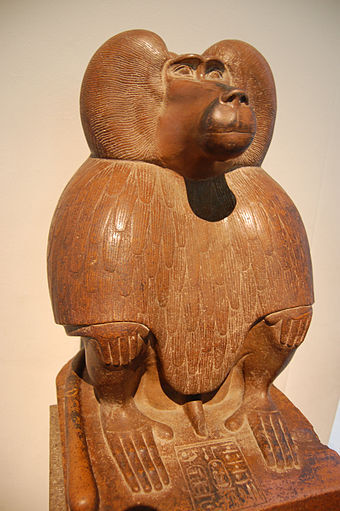 Ancient Egyptian image of the wise and sexually potent hamadryas
Ancient Egyptian image of the wise and sexually potent hamadryasThe Baboon
The Egyptian sacred baboon has been identified as the hamadyras baboon. Unfortunately, it is now extinct in Egypt, and possibly had to have been imported even into ancient Egypt. With their expressive faces and cleverness, they were considered sacred to the Great Magician Thoth. He sometimes even took the form of a hamadryas.
As a creature of Thoth, these baboons were associated with the moon and you often see images of them with a lunar disk above their heads. But they were also sun-connected. When these diurnal monkeys awaken, they stretch their arms up as if praying and vocalize. To the ancients, they were awakening and praising Re in His rising.
 A familiar posture to the ancient Egyptians. Handy built-in butt cushion, too.
A familiar posture to the ancient Egyptians. Handy built-in butt cushion, too.Because of this, great wisdom was attributed to the baboons and they were considered to be the keepers of secret religious knowledge. In the Book of the Dead, the deceased declare themselves to be one of the baboons who sing and praise the sun as it rises. In a different part of the same text, the baboons “raise up truth to the Lord of All” and they are the ones who offer the best praise and offerings to the Deities and the dead. They are said to “live on truth, feed on truth, and whose hearts have no lies.” These same things are also said of the Deities and of the king. Thus, these sacred baboons are of a high stature.
 Thoth in baboon-form, with lunar disk, guiding the work of a scribe
Thoth in baboon-form, with lunar disk, guiding the work of a scribeThe sunrise vocalizations were even considered to be a sacred baboon language that human beings could not comprehend, but which contained the secrets of the baboons’ ecstatic praise that so pleased the Deities. One magical text (the Harris papyrus) invokes a holy baboon “whose lips are fire and each of whose words is a glowing flame.” Horapollo, who in the 5th century CE wrote a book explaining what he knew about Egyptian hieroglyphs, says that the sacred baboons also knew the hieroglyphs…and some could even write the holy glyphs. In an attempt to find out which ones knew the sacred language, Horapollo says that the priests would give a young baboon a writing stylus, ink, and a tablet to see if he was one of the ones who could write hieroglyphs.
This idea, no doubt, was because of the baboon’s connection with—and sometimes manifestation as—Thoth, the inventor of writing. Like Her compatriot, Isis too, was known to have invented writing. Her aretalogy from Maroneia says, “With Hermes [Thoth] she discovered writings, the sacred ones of these for the initiated, and the demotic for all.”
It is fitting that words and language be under the purview of Isis and Thoth, the two Great Magician Deities of ancient Egypt. For words are magic. Silently, through signs and symbols, thoughts, ideas, and desires can be transmitted from one person to another, and from one to many. Hekau, words of magic, words of power, cause things to change—and most especially when spoken by Isis and Thoth, Lady and Lord of Words of Power. (Read more about Isis as the Great Word here. Read more about Isis and Thoth here.)
And so, in my new sacred image of Isis, I take the baboon under Her right hand to be an image of Her potency as Iset Hekaiet, Isis the Magician, Isis the Lady of Words of Power.
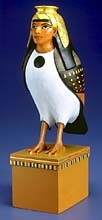 Queen Nefertari’s ba
Queen Nefertari’s baThe Ba-Bird
Beneath Her left hand is a ba-bird, a human-headed image of one of the aspects of the human being that survives after death. As a funerary Goddess, Isis has always been connected to the Land of the Dead.
In the earliest Egyptian texts, the ba appears to be a Divine force, such as the manifestation of a Deity. By the end of the Old Kingdom, the concept of the ba was understood more broadly. Everybody—and some things as well—had one.
While the ba concept is much more complicated, for convenience it is usually just translated as “soul.” Interestingly, it was first so translated by the same Horapollo mentioned above. He translated Egyptian ba as Greek psyche, which further translates to “soul” in English. Generally, the ba is a non-physical aspect of person that comprised their personality or character and is a manifestation of the human being in the spiritual realm.
 An Egyptian couple with their bau (pl.) before them
An Egyptian couple with their bau (pl.) before themThe ba is usually depicted as a human-headed bird having the same face as the deceased to whom it belongs. While its human face identifies it as personal to the individual, its bird wings give it the ability to fly “between the worlds.” The winged ba can move freely in the spiritual realms, coming and going as it will.
 A man welcomes his ba in the otherworld
A man welcomes his ba in the otherworldAs an immortal and eternally renewing part of all beings, the ba appropriately comes under the wings of Isis, Lady of Souls, Who cares for and renews us in the afterlife, just as She did for Osiris. It is She Who initiates the ba into its new, transformed existence without the living body of the deceased. She is the Lady of All in the Secret Place and She is asked by the deceased in the Coffin Texts to, “spiritualize me, O you who split open my mouth for me and who guide my soul [ba] on the paths of the Netherworld.”

As Isis entered the Graeco-Roman world, She continued Her association with souls as a Mystery Goddess. In Her famous Mysteries, initiates learned what lay before them in the afterlife so that they lost their fear of death and could live more fulfilling lives on earth. Isis was also known as a Savior Goddess. This not only pertains to Her ability to initiate our souls into the Mysteries of Death, but also to Her saving grace in our day-to-day lives.
 A Graeco-Roman Isis
A Graeco-Roman IsisIn a Hermetic treatise, the Kore Kosmou, Isis is also associated with souls. In the text, She describes for Horus how human souls were created and how She and Osiris devised the “magic of the prophet-priests” so that human souls could be nurtured by philosophy and human bodies could be healed by the magical arts.
My new sacred image of Isis celebrates this aspect of Her power for me: She is the Lady of All in the Secret Place, the Goddess Who protects and renews the souls, including mine.
I hope I can someday find the ancient Egyptian original of this image. If you spot it, be sure to let me know.
April 16, 2023
Isis, Lady of the Air
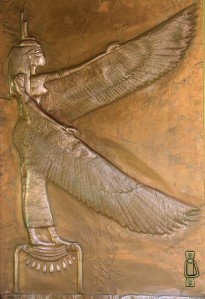 Isis, Mistress of Wind
Isis, Mistress of WindDeep breath. In and out.
I don’t know about where you are, but here in the Pacific Northwest, it is…just…beginning to feel like spring. Finally, finally. So far, it’s been a chilly spring, but the air is starting to feel different now, softer, greener.
So today, let us take a deep, cleansing breath and honor Isis as Lady of the element of Air—of Breath, of Wind, and thus of Spirit.
It’s quite true that many cultures associate breath, air, and wind with Spirit. For while these things are invisible, they are invisible Powers, and we are intimately touched by their influence. We breathe the air and we live. The wind fills a sail and we move. Wind, air, and breath thus can be seen as manifestations of the invisible powers of the Deities.
Perhaps that is why my favorite title for an Egyptian book of the dead is the Book of Breathings. It is the book “which Isis made for her brother Osiris, to make his ba live, to make his body live, to make young all his members” and it especially emphasizes the importance of breath for resurrection. The Lady of the Breath of Life fans Her wings and puts “wind” into Osiris’ nose. The God lives and His Divine Spirit revives when He “smells the air of Isis.” You can read more about the Book of Breathings here and the rather strange tale of how a copy of it came to the United States.
In Isis, breath, air, wind, and spirit are one.
In the Book of Coming Forth by Day, Isis declares that She comes “with the north wind.” The Goddess and the wind were associated because both were known to bring the cooling, life-giving waters of the Inundation. It was thought that the north wind “dammed up” the Inundation, which flowed from the south, enabling the water to flood and nourish Egyptian fields. Thus, Isis is the one Who heralds the Inundation and causes it to flow (as Iset-Sopdet), but also Her northerly winds keep it in place so that it will water and fertilize the fields.
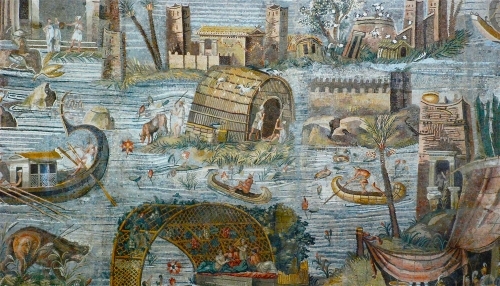
A fanciful Italian mosaic, from the Hellenistic period, showing Egypt during the Inundation
As Iset Mehit, Isis of the North and Lady of the North Wind, the Goddess brings the sweet-smelling north wind and all good things. Temple texts at Edfu identify Her with the “good north wind.” In the Book of Hours, She is the “living north wind.” Isis is especially found whenever air is active, whether in beating wings or gusting winds. Some stories describe Her mourning cries for Osiris as the wailing and moaning of the winds.
 Today, the wind provides power in Egypt; this is the Zafarana wind farm
Today, the wind provides power in Egypt; this is the Zafarana wind farmIsis can be a controller of the winds, too, for it is She Who promises the king in the Pyramid Texts (Utterance 669), “the south wind shall be your wet nurse and the north wind shall be your dry nurse.” The wind or breath of Isis can also purify. In the Pyramid Texts (Utterance 510), the deceased is cleansed with a vessel “which possesses the breath of Isis the Great.” In a work by the Roman writer Lucian, Isis is invoked to send the winds.
In the myth of the Contendings of Horus and Set, when the Ennead finally rules in favor of Horus to succeed His father Osiris, Isis sends the north wind—which She both controls and personifies—to bring the good news to Osiris in the underworld.
Isis can also be connected to other directional winds. In the Book of Coming Forth by Day (Chapter 161), the four winds are attributed this way: Osiris is the north wind, Re is the south wind, Isis is the west wind, and Nephthys is the east wind. As the winds, these Deities enter the noses of the dead and bring them to life.
 Elemental de Aire by Ades21 on Deviant Art
Elemental de Aire by Ades21 on Deviant ArtIsis is not the only Deity associated with the winds and air, of course. Wind is also the manifestation of Amun, the Hidden One, of Shu, the God of Air and Light, and of Atum, the Creator. In the Book of Coming Forth by Day, an otherwise unidentified “Great Goddess, Mistress of Winds” brings benefits to the deceased. In the Coffin Texts, the deceased calls himself “Mistress of the Winds in the Island of Joy.” Another tells us that the deceased receives the breath of life from four primordial Maidens associated with the four winds and Who existed “before men were born or the gods existed” (Formula 162).
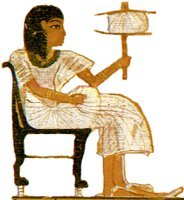 The deceased holds a sail to catch the breath of life
The deceased holds a sail to catch the breath of lifeThe Book of Coming Forth by Day sometimes shows the deceased holding a sail to catch the breath of life. Since the dead are identified with Osiris, it would make sense that the sail is intended to help them magically catch the air fanned into the dead by the powerful wings of Isis.
In a later period, images of Isis Pharia show the Goddess Herself holding a sail. The billowing sail of Isis Pharia ensures smooth sailing on the seas as in life. Perhaps this later image harks back to Isis’ more ancient attribution as She Who fills the sails of the dead with breath and life.
In Graeco-Roman texts of about the same period as the Isis Pharia images, Isis “hast dominion over winds and thunders and lightnings and snows” and She declares in one of Her aretalogies, “I am the Queen of rivers and winds and sea.” Read more about Isis Pharia here.
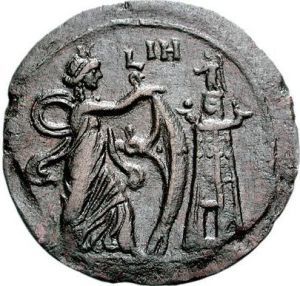 Isis Pharia with Her sail and the lighthouse on the right
Isis Pharia with Her sail and the lighthouse on the rightA second-century-CE papyrus found in Oxyrhynchus, Egypt calls Isis the “true jewel of the wind and diadem of life.” A hymn at the Goddess’ Faiyum temple connects Her with the winds, too: “Whether you have journeyed to Libya or to the south wind, or whether you are dwelling the outermost regions of the north wind ever sweetly blowing, or whether you dwell in the blasts of the east wind where are the risings of the sun…”
In whichever wind She dwells, Isis is always the ancient Lady of the Living Air, Queen of the Winds, Winged Goddess of the Spirit Revivified. From Her we receive our breath and our life.
April 9, 2023
On Resurrections and Do-Overs
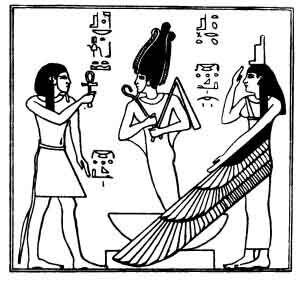 Osiris rising, protected by the wings of Isis
Osiris rising, protected by the wings of IsisWe human beings are always looking for a second chance, a new beginning, a do-over. And most of the time, we can have one. But usually, even when we get one, things have to change for the magic to really work. While a new moon or a new year offers the opportunity for change, we have to put in the effort to make the change happen and we must persist to ensure it continues happening.
I participated in just such a new beginning last night, and I have another, related event tonight. So today’s post will be short on text. Instead, I’d like to share with you some images of resurrection, mostly but not all, of Osiris. For His resurrection teaches that important lesson about change. When Isis resurrects Him, everything doesn’t just go back to the way it was. Instead, Osiris is now alive in the underworld, becoming part of the cycle of birth-death-rebirth that is so vital for the renewal of all things.
 Isis with Horus in hawk form preparing to raise Osiris
Isis with Horus in hawk form preparing to raise Osiris
 The Resurrection of Osiris by Alexander Tyne. You can see his art here. This is Isis in Her “O Zephyr Winds…” phase
The Resurrection of Osiris by Alexander Tyne. You can see his art here. This is Isis in Her “O Zephyr Winds…” phase 
 An image of the dead Osiris from Denderah; I love the growth of roots beneath Him. You can’t see this here, but Isis and Nephthys are at His head and feet preparing to work Their magic on Him. He is shown here within the tree from which He will be reborn.
An image of the dead Osiris from Denderah; I love the growth of roots beneath Him. You can’t see this here, but Isis and Nephthys are at His head and feet preparing to work Their magic on Him. He is shown here within the tree from which He will be reborn.
 Another image where the corpse of Osiris is shown sprouting new life, encouraged by the light of the sun. From the coffin of Nespawershefit. 21st dynasty. This shows one of the great Egyptian Mysteries: the joining of Osiris and Re and the renewal that joining brings to both of Them.
Another image where the corpse of Osiris is shown sprouting new life, encouraged by the light of the sun. From the coffin of Nespawershefit. 21st dynasty. This shows one of the great Egyptian Mysteries: the joining of Osiris and Re and the renewal that joining brings to both of Them.
 Often, the in-the-process-of-being-resurrected Osiris is shown as His djed pillar. Here He is between the magical wings of Isis and Nephthys; also from a coffin, but I couldn’t find the precise source.
Often, the in-the-process-of-being-resurrected Osiris is shown as His djed pillar. Here He is between the magical wings of Isis and Nephthys; also from a coffin, but I couldn’t find the precise source.
 The same Mystery more clearly shown: Osiris as Djed and Re as Solar Disk are joined by the Ankh of Life.
The same Mystery more clearly shown: Osiris as Djed and Re as Solar Disk are joined by the Ankh of Life.
 Here Isis and Nephthys raise a very curved Osiris with the solar disk touched by His limbs.
Here Isis and Nephthys raise a very curved Osiris with the solar disk touched by His limbs.
 Within the body of curved Osiris, we now see the child Horus Who will be birthed by Isis, a fertility-connected kind of resurrection.
Within the body of curved Osiris, we now see the child Horus Who will be birthed by Isis, a fertility-connected kind of resurrection.
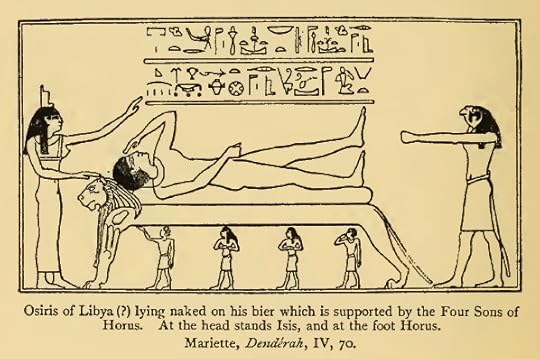 This drawing is from one of the images at Denderah pertaining to the resurrection of Osiris. Note the position of His right hand. This drawing is from the 1800s and the copyist didn’t want to depict the penis that was in His hand. His fertility was being raised, too, like a…well, like a djed pillar we could say.
This drawing is from one of the images at Denderah pertaining to the resurrection of Osiris. Note the position of His right hand. This drawing is from the 1800s and the copyist didn’t want to depict the penis that was in His hand. His fertility was being raised, too, like a…well, like a djed pillar we could say.
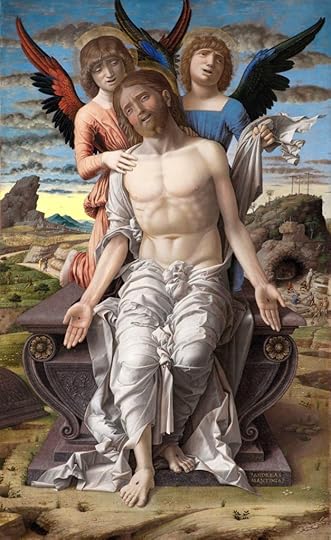 Lots of people get that raised phallus-resurrection connection. The Christos as Man of Sorrows by Andrea Mantegna, about 1500 CE.
Lots of people get that raised phallus-resurrection connection. The Christos as Man of Sorrows by Andrea Mantegna, about 1500 CE.
 Not blatant at ALL in this engraving by Ludwig Krug…
Not blatant at ALL in this engraving by Ludwig Krug…
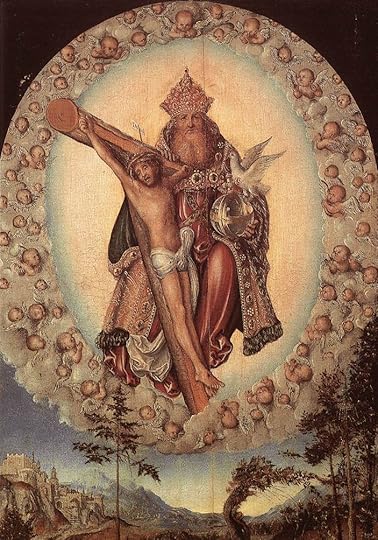 …or this one by Lucas Cranach.
…or this one by Lucas Cranach.
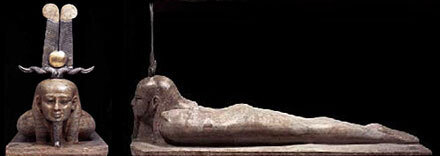 But Osiris is my Resurrection Guy, as in this beautiful statue.
But Osiris is my Resurrection Guy, as in this beautiful statue.Before Osiris could rise, He had to roll over on His stomach and raise His head. To me, this reinforces our lesson about do-overs. We must make an effort. Once the Two Sisters had worked Their magic, Osiris still had to raise His own head to complete the magic.
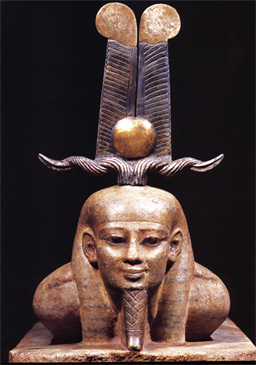 Here’s a close up of His serene and beautiful face. The expressions on the face of many images of Osiris remind me of the serenity of some images of the Buddha. This is one of those.
Here’s a close up of His serene and beautiful face. The expressions on the face of many images of Osiris remind me of the serenity of some images of the Buddha. This is one of those. And so I wish you strength, persistence, and the holy magic of Isis, Nephthys, and all your own Divine Ones to assist you as you work your own magic of change, new beginnings, and all the do-overs you may need. I know I need them.
April 2, 2023
First Steps with Isis

Many of you are beyond your first steps with Isis.
If so, I hope you will comment and add to this post your own thoughts about your first steps with Isis. But many of you—perhaps coming across this blog searching for information about Her—are looking to take your first steps, and wondering how to do so.
Perhaps you have had a dream. (Yes, She often calls to us through dream.) Perhaps you have repeatedly come across Her name or Her images. Like repeatedly. Perhaps you had an oracle or a tarot reading. Perhaps you simply had a feeling that leaves you wondering, “is this Isis?”
Sometimes, it might be something more dramatic, like a powerful experience at a festival or in circle or in your private meditations, an experience that leaves you in no doubt that SOMETHING has occurred. (For instance, back in the early days of forming my relationship with Her, I heard Her speak my name, loudly and emphatically and just once. It sounded as though I had heard it with my physical ears, not my metaphysical ones. So powerful was this calling that I still vividly, vividly remember it many years later.)

What to do? First, know that you don’t have to do anything. You can totally ignore these promptings. If now is not the right time for you to take on this connection, you don’t have to. But I would gently and kindly suggest that you be gentle and kind, too, and tell Her, “no, thank You.” If this is something you just don’t want, ever, that’s okay. But if your response is, “not now, maybe later,” let Her know that, too.
In most cases, Isis will take no for an answer. If your dreams or other promptings continue after your refusal, then there may be something She feels you need to know or take care of, even if it’s not a relationship with Her. How you handle this depends on your own specific circumstances.
But let’s say you do want to enter into a relationship with Isis. Now what?
There are some things you can do right away. First, read, read, read. Since you’re here, read back over older Isiopolis posts. In the sidebar, check out the archives. There’s a lot of information here about Isis, things that will help guide your understanding of Her nature. Sometimes, I’ve even written of my own experiences with Her. That will help give you an idea of what interactions with Her might be like. (Yes, of course, your interactions will be distinctly yours, but it does help to know what others have experienced.)
Reading everything from the experiences of modern devotees to the research of scholars is valuable in learning how your experiences match up with those of others, now and throughout the history of Her worship.

In addition to reading, see if you can find a space that can serve as a focus for your interactions with Her. In many cases, this will be an altar space. This can be as simple or elaborate as you like and as you have the ability to create. Choose a corner of your room or a small table that you can devote for this purpose. If you don’t have space like that, or if you’re a young person living at home and your parents might object, something as simple as a picture of Her on your wall or above your bed will suffice. Just make it somewhere you can sit either before or near during your meditations.
Once you have made the decision to explore a relationship with Isis and have some kind of a focus for your devotions, I would suggest making a formal vow to express your dedication to this exploration. Don’t make it a forever-vow. Make it for six weeks, or six months, or a year. At the end of the time you’ve chosen, you can re-access and decide whether you wish to continue beyond that time.

Making Your Dedication
Your dedication can be something as simple as lighting candles at your altar and speaking your intention or something as elaborate as the ritual of “Tying the Knot of Isis” from Isis Magic. On the simpler side, here are some words you can use or adapt in making your vow:
Words of Power of the Votary of Isis:
Hear me, Isis, and take my hand. Make fast the Knot that unites me with Thee. Grace me, Goddess, with Thy presence. I ask Thee with the breath of my body; I ask Thee with the thoughts of my mind; I ask Thee with the beat of my heart—to hear me. And open to me as I open to Thee. I speak Thy name, Isis. I drink in Thy love. I am for Thee, Goddess. I am Thy votary* for the period of . Accept these words of power, Isis, and all things beautiful and pure. Amma, Iset [AH-mah, Ee-set].
Isis Magic, 2nd edition
Following your dedication, your threefold work begins: the development of openness to Isis, the unfolding of hope, and the practice of expectation.
Developing Openness to Goddess
Being open to Isis is a subtle thing. It involves openness both of mind and of the subtle body often known as the aura, the subtle energy field that surrounds each human being and all manifested things. Openness of mind does not mean we need to give up skepticism. Indeed, we should not. We only need to be able to suspend its judgment while doing meditations and other exercises that put us in touch with the Goddess. Analyze later. Experience now. To do this, try to be present in each moment and be open to the very real possibility that Isis is indeed with you.

In addition to opening our minds to the possibility of the presence of the Goddess, as votaries, we work to cultivate openness of our aura to Isis. Opening the aura to Her is, in part, a physical openness. You can use the Opening of the Ways ritual to safely and gently open your aura to Isis, a process that will help you feel Her near you, within you, around you.
Unfolding Hope
These two types of openness—of mind and aura—encourages a third: openness of spirit. Spiritual openness feels like hope; thus it is said that part of the work of the Votary is the unfoldment of the wings of hope. Hope opens us to greater possibilities. Hope is a buoyant desire, a longing that can enlarge the spirit. During this early part of your exploration with Isis, you are urged to encourage hope in yourself…and in others.
Practicing Expectation

First, hope for and then, expect Isis’ presence. Like hope, the practice of expectation is a spiritual openness to possibility. Teach yourself to expect the touch and presence of Goddess. Isis is with us. Both in ancient times and today, many have felt Her presence. Many know Her reality. So can you. There is every reason to expect that Isis will make Herself known to you as you open yourself to Her. Being open and hopeful and expectant, you will see signs and portents everywhere. Does a breeze rustle the leaves of a tree as you pass, thinking of Her? It is Her breath. Have you found a piece of jewelry engraved with Her image? She confirms your Path. Did that hawk circle above you as you drive your car down a country road with Her name on your lips? She is guiding you.
It is not foolish to see such signs at every turn. Rather, it is Foolish. Like the Sacred Fool of the Tarot, we are stepping off the cliff, looking upward to Isis, trusting—hoping and expecting—that She will guide our steps. And we shall find, I promise you, that indeed She does. This trust in the Goddess brings a unique and blessed state of freedom that you will discover for yourself as you develop your relationship with Isis, taking those first steps with Her.
*A votary is simply one devoted to something, in this case devoted to Isis for a specific period of time. This does not preclude any other devotions you may be undertaking with other Deities. Isis does not require exclusivity.



